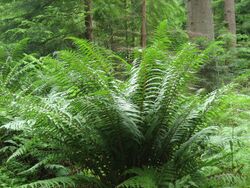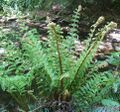Biology:Dryopteris affinis
| Dryopteris affinis | |
|---|---|

| |
| Scientific classification | |
| Kingdom: | Plantae |
| Clade: | Tracheophytes |
| Division: | Polypodiophyta |
| Class: | Polypodiopsida |
| Order: | Polypodiales |
| Suborder: | Polypodiineae |
| Family: | Dryopteridaceae |
| Genus: | Dryopteris |
| Species: | D. affinis
|
| Binomial name | |
| Dryopteris affinis (Lowe) Fraser-Jenk.
| |
Dryopteris affinis, the scaly male fern or golden-scaled male fern, is a fern native to western and southern Europe and southwestern Asia. It is most abundant on moist soils in woodlands in areas with high humidity, such as the British Isles and western France. In the Mediterranean region and the Caucasus it is confined to high altitudes.
Description
Dryopteris affinis is virtually evergreen and bears light green fronds 60–160 cm (24–63 in) long, moderately stiff and hard-textured, the rachis at the base of the frond densely covered in yellow-brown scales known as ramenta. The frond is bipinnate, the pinnae up to 8–18 cm (3–7 in) long, the pinnules broad rectangular with the margin most toothed close to the pinna tip.[1]:444[2] There is a blackish spot at the base of the pinna where it joins the rachis.[1][2]
Individual fronds live for about 1.5 years and remain attached to the rhizome after withering. D. affinis is closely related to Dryopteris filix-mas, distinguished by its usually more robust habit with usually more evergreen fronds, more densely scaly frond stems, and more rectangular (less tapered and lobed) pinnae and pinnules.[citation needed]
It is one of the larger European native ferns, with older specimens developing a dense, almost tree fern-like base up to 20–30 cm (8–12 in) high and 30–40 cm (12–16 in) broad.
Cultivation
Numerous cultivars and varieties have been selected for garden use, of which the following have gained the Royal Horticultural Society's Award of Garden Merit:[3]
- D. affinis[4]
- 'Polydactyla Mapplebeck'[5]
- 'Crispa Gracilis'[6]
- 'Cristata'[7]
- 'Cristata Angustata'[8]
References
- ↑ 1.0 1.1 Blamey, M.; Fitter, R.; Fitter, A (2003). Wild flowers of Britain and Ireland: The Complete Guide to the British and Irish Flora.. London: A & C Black. ISBN 978-1408179505.
- ↑ 2.0 2.1 "West Highland Flora: Scaly male fern". http://www.plant-identification.co.uk/skye/aspidiaceae/dryopteris-affinis.htm.
- ↑ "AGM Plants - Ornamental". Royal Horticultural Society. July 2017. p. 33. https://www.rhs.org.uk/plants/pdfs/agm-lists/agm-ornamentals.pdf. Retrieved 6 February 2018.
- ↑ "Dryopteris affinis". Royal Horticultural Society. https://www.rhs.org.uk/Plants/22167/Dryopteris-affinis/Details. Retrieved 2020-04-17.
- ↑ "Dryopteris affinis (Polydactyla group) 'Polydactyla Mapplebeck'". Royal Horticultural Society. https://www.rhs.org.uk/Plants/113943/Dryopteris-affinis-(Polydactyla-Group)-Polydactyla-Mapplebeck/Details. Retrieved 2020-04-17.
- ↑ "Dryopteris affinis 'Crispa Gracilis'". Royal Horticultural Society. https://www.rhs.org.uk/Plants/48153/Dryopteris-affinis-Crispa-Gracilis/Details. Retrieved 2020-04-17.
- ↑ "Dryopteris affinis 'Cristata'". Royal Horticultural Society. https://www.rhs.org.uk/Plants/131417/Dryopteris-affinis-Cristata/Details. Retrieved 2020-04-17.
- ↑ "Dryopteris affinis 'Cristata Angustata'". Royal Horticultural Society. https://www.rhs.org.uk/Plants/99611/Dryopteris-affinis-Cristata-Angustata/Details. Retrieved 29 April 2020.
External links
- Flora Europaea: Dryopteris affinis
- Hyde, H. A., Wade, A. E., & Harrison, S. G. (1978). Welsh Ferns. National Museum of Wales.
Wikidata ☰ Q2036293 entry
 |




